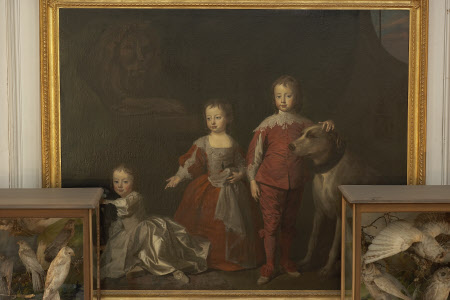The Three Sons of Sir Henry Harpur 5th Bt:John Harpur (1734/5 – 1745); Henry Harpur later Sir Henry ‘Harry’ Harpur, 6th Bt (1739-1789) and Charles Harpur, later Major Charles Harpur (1741 – 1770) (style of Van Dyck)
Thomas Hudson (Devonshire 1701 – Twickenham 1779) and Joseph van Aken (Antwerp 1709 - London 1749)
Category
Art / Oil paintings
Date
1745
Materials
Oil on canvas
Measurements
1530 x 1880 mm
Place of origin
England
Order this imageCollection
Calke Abbey, Derbyshire
NT 290421
Summary
Oil painting on canvas, The Three Sons of Sir Henry Harpur 5th Bt: John Harpur (1734/5 – 1745); Henry Harpur later Sir Henry ‘Harry’ Harpur, 6th Bt (1739-1789) and Charles Harpur later Major Charles Harpur (1741 – 1770) by Thomas Hudson (Devonshire 1701 – Twickenham 1779) and Joseph van Aken (Antwerp 1709 - London 1749), 1745. Portraying three children after the portrait by Van Dyck of the children of Charles I. John, on the right, dressed in a crimson suit, rests his hand on the head of a mastiff. Henry, in the middle wears a red dress with lace trimming, and Charles sits on the carpet wearing a white dress and fondling a black and white spaniel. Behind is a stone lion in the dark background (inventory card). Isabel Harpur Crewe commented in this portrait; 'The eldest boy (John on the right) died at school aged twelve, and the second son (Henry, centre) succeeded to the Baronetcy, the third (Charles, left) became a major in the army, and died suddenly at Twyford Hall aged 27'. The Calke account books record a payment to Thomas Hudson for 50 guineas in December 1745 which accords with the ages of the children shown. Hudson uses the famous portrait of the older children of Charles I by Van Dyck at Windsor as his model for both the costume and pose of the eldest boy and the mastiff.
Credit line
Calke Abbey, The Harpur Crewe Collection (acquired by the National Trust with the help of the help of the National Heritage Memorial Fund in 1984)
Makers and roles
Thomas Hudson (Devonshire 1701 – Twickenham 1779) and Joseph van Aken (Antwerp 1709 - London 1749), artist Thomas Hudson (Devonshire 1701 – Twickenham 1779), artist

